When the KBO announced it would start its regular season May 5, we at RotoWire hoped for two events to happen — that DFS companies would start offering KBO contests, and that a U.S. TV network would start broadcasting games. The latter wasn't absolutely necessary to create a market for our coverage, or for people to start playing a DFS contest, but it would certainly help drive up interest.
Fortunately, both desires have morphed into reality. DraftKings, FanDuel and Dream11 have created KBO contests on their respective platforms, and ESPN at the 11th hour struck a deal to televise games in the U.S. with Eclat, the Korean company with the worldwide distribution rights.
For the last week, we've kicked it into high gear to create our KBO section on the site — both forward facing and in our admin area where we post all of our content. Clay Link has done yeoman's work in populating our database — projected starters, depth charts, you name it — and Erik Halterman has generated a ton of DFS content already.
Projection Process
My job was to generate a set of player projections, which we'll eventually use in our optimizer and other tools. The process has been incredibly challenging. Not only did I not know most of the player pool, but we didn't start with a database of players, rosters or teams — that's something we had to develop, but I had to get started before we had that. That in and
When the KBO announced it would start its regular season May 5, we at RotoWire hoped for two events to happen — that DFS companies would start offering KBO contests, and that a U.S. TV network would start broadcasting games. The latter wasn't absolutely necessary to create a market for our coverage, or for people to start playing a DFS contest, but it would certainly help drive up interest.
Fortunately, both desires have morphed into reality. DraftKings, FanDuel and Dream11 have created KBO contests on their respective platforms, and ESPN at the 11th hour struck a deal to televise games in the U.S. with Eclat, the Korean company with the worldwide distribution rights.
For the last week, we've kicked it into high gear to create our KBO section on the site — both forward facing and in our admin area where we post all of our content. Clay Link has done yeoman's work in populating our database — projected starters, depth charts, you name it — and Erik Halterman has generated a ton of DFS content already.
Projection Process
My job was to generate a set of player projections, which we'll eventually use in our optimizer and other tools. The process has been incredibly challenging. Not only did I not know most of the player pool, but we didn't start with a database of players, rosters or teams — that's something we had to develop, but I had to get started before we had that. That in and of itself proved to be a problem. I had two primary sources to determine which players to project: Dan Kurtz's excellent MyKBO.net and Baseball-Reference.com's KBO section. The problem? There are many instances where the player names for each site are spelled differently. Sometimes it's just by a letter here-and-there, other times it's dramatically different. I ultimately used MyKBO.net's version for my first wave until we had our own stats provider, but that added another reconciliation step later. I did that because Dan has a depth chart feature, which helped me whittle down the list of players on the current roster, which was very helpful.
OK, now that we've identified the players we want to project, what other issues do we have to account for when doing our projections? I typically begin with three-year weighted averages as my starting point for MLB projections, then adjust for a medley of factors — Statcast info, age, change in ballparks/managers/roles and injury information. When a player doesn't have a solid three consecutive years in the majors, I have to adjust playing time accordingly, or in many cases try to extrapolate from minor league stats.
Going through this process with KBO players isn't as cut-and-dried. For one, it's harder to find a three-year sample for the players. South Korea has a military requirement between the ages of 18 and 28 that typically results in a two-season absence for the players. I'm still looking for a source of current players serving that commitment, or if there's a typical timeframe when baseball players serve that commitment, but for the most part exceptions to this requirement have been few and far between.
That, of course, has the effect of breaking up a player's development in some of his prime seasons, and the continuity of a starting lineup. Another factor is the difficulty in finding minor league stats for KBO players. There is a minor league system connected to the KBO, titled the "KBO Futures," but I haven't yet found stats connected to those players, nor do I have much of an idea about the level of play and how they would compare to minor league equivalents in the U.S. Frequently on a team's roster there will be a handful of players 19-22 years old with very few KBO appearances, yet might play this year. I'll hopefully get a better grasp of them the longer this goes on.
But the most influential challenge in creating these projections is the fact that the KBO changed the ball in 2019, significantly "de-juicing" it. The decision had a dramatic impact:
| YEAR | TEAM BA | HR/G | R/G | RBI/G |
|---|---|---|---|---|
| 2018 | .286 | 1.22 | 5.55 | 5.26 |
| 2019 | .267 | 0.70 | 4.55 | 4.29 |
With three-year weighted averages, we already place primary emphasis on the most recent season in most instances. But when circumstances have materially changed, as they have here, we need to place even more emphasis on the 2019 stats. That applies for both batters and pitchers. I tried to do that with each projection, though with the variance in playing time between players, I fear that I might not have done it quite evenly.
Valuation Process
Following all of that, I now had a set of projections, but to get a good set of rankings, I like to put in a valuation component. Just as I could apply SGP's to a 1982 data set to complete a set of rankings, I could do so with my KBO projections. There are two important distinctions, however. I projected far fewer players (128 hitters, 109 pitchers) than I would do for a normal run of MLB players. That's both because I needed a quick turnaround, but also, and more importantly, there are only 10 KBO teams. It's pretty difficult to have a traditional 12-team roto league with such a league size. I decided that my hypothetical league would have eight teams, and those teams would carry 13 hitters (only one catcher) and eight pitchers.
The other massive distinction is the league hitting/pitching environment, compared to that in MLB. You saw that chart above comparing 2018 to 2019, but how does that compare to MLB, while also factoring in stolen bases? First, on the hitting side:
| BA | HR | R | RBI | SB | |
|---|---|---|---|---|---|
| KBO 2019 | .267 | 0.70 | 4.55 | 4.29 | 0.69 |
| MLB 2019 | .252 | 1.39 | 4.83 | 4.62 | 0.47 |
No, this is not a Three True Outcomes league, to say the least. KBO games featured nearly half the homers that MLB saw last year, albeit in a record year highlighted by Happy Fun Ball in the U.S. But also notice the considerably higher batting average (though nowhere near the astounding .286 in 2018!), and the stolen base rate that's 46 percent higher than your average MLB game. It's almost as if I'm playing in a 1990 league here!
And here's the pitching comparison:
| ERA | WHIP | K's/G | SV/G | |
|---|---|---|---|---|
| KBO 2019 | 4.17 | 1.40 | 6.66 | .24 |
| MLB 2019 | 4.51 | 1.33 | 8.81 | .24 |
You can see what a heavy contact league the KBO is — again, this is more similar to the early 90s in MLB in terms of the strikeout rate. Notice the significantly higher WHIP — that's attributable to the higher league-wide batting average, with many more balls in play. The average walk rate (3.21) is actually lower than MLB's 3.27 rate.
Hitter Values
With all that in mind, here are the dollar values with the player projections for the hitters. I'll break them up in groups for spacing sake.
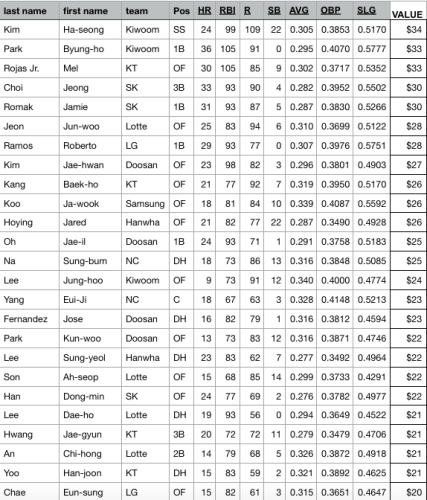
Foreign-born players typically have done quite well in the KBO, most notably Eric Thames, a two-time MVP, and Josh Lindblom on the pitching side last year doing the same for the champion Doosan Bears. And it's no different here — Mel Rojas Jr., Jamie Romak, Roberto Ramos, Jared Hoying and Jose Fernandez show up well here. But it's noteworthy that two Korean-born players top the list in Ha-seong Kim and Byung-ho Park, both from the Kiwoom Heroes. Park, of course, had a failed stint with the Minnesota Twins, but he's been fantastic ever since returning home.
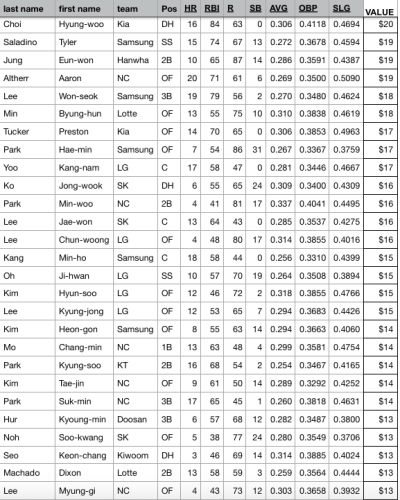
There are three newcomers to the KBO here — Tyler Saladino, Aaron Altherr and Opening Day's hero, former Tigers middle infielder Dixon Machado. There's another familiar name in former Orioles outfielder Hyun-soo Kim on the LG Twins.
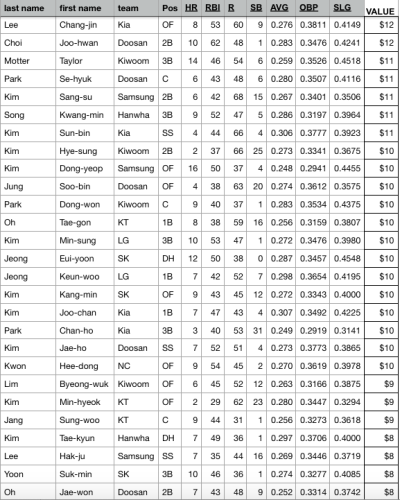
There's another newcomer in former Rays and Mariners infielder Taylor Motter, who joins my favorite new team in Kiwoom. I'm not as optimistic about his chances for success as the other incoming players.
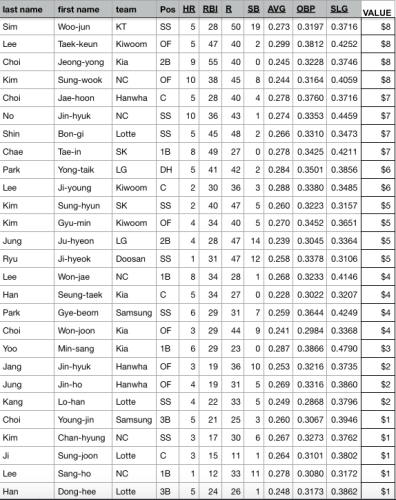
And finally ...
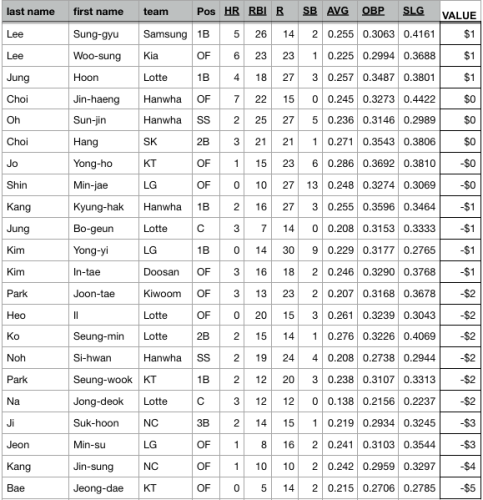
Pitcher Values
You've seen the hitters, let's now take a quick look at the pitcher values.
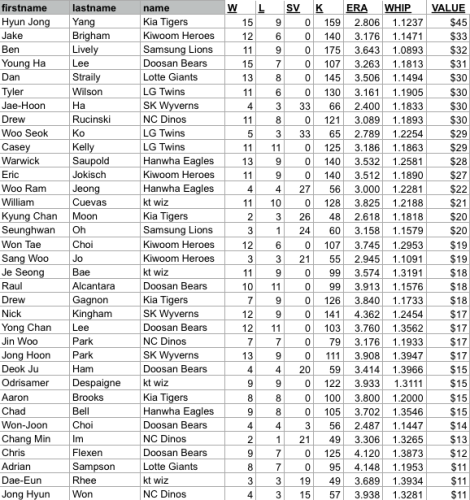
There's a pretty steep drop-off from the top of the starting pitching pool to those remaining. I wonder if I overvalued Hyun Jong Yang, the Kia Tigers' ace and the long-time best Korean-born pitcher. It's also possible that I might have underestimated what some of the new foreign-born players could accomplish in the KBO. Each team is limited to three foreign players — one hitter and two pitchers. Many of those pitchers have already pitched in the first two games of the season, though on some teams those debuts were delayed by a slow return to speed following a 14-day quarantine after returning to South Korea if they left during the breakout of the COVID-19 virus.
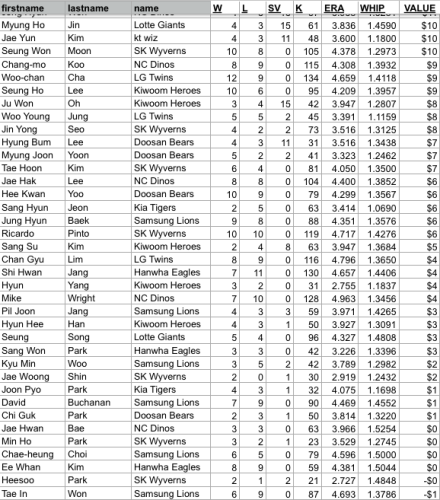
When you start dipping into the third and fourth starters on a number of the lower-division teams, you can start to see the gap between the "haves" and "have-nots." The pitching for Samsung and Hanwha was particularly dreadful last year. Here's the final batch:
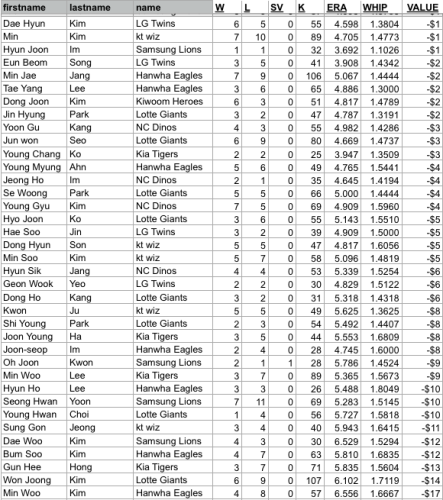
So far I haven't seen a commissioner service that supports season-long KBO, but if one pops up, hopefully this will get you started, and perhaps in the interim this will help you identify some DFS bargains along the way.








